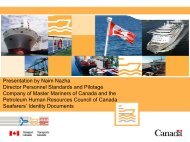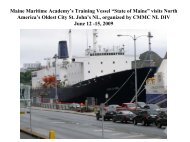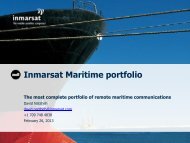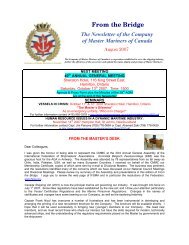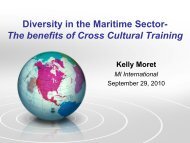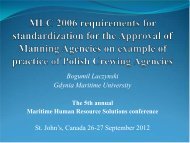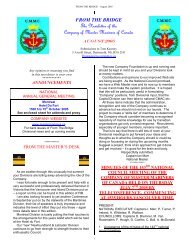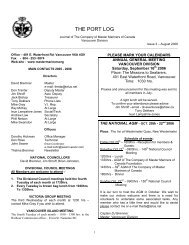From the Bridge - Company of Master Mariners of Canada
From the Bridge - Company of Master Mariners of Canada
From the Bridge - Company of Master Mariners of Canada
You also want an ePaper? Increase the reach of your titles
YUMPU automatically turns print PDFs into web optimized ePapers that Google loves.
“<strong>From</strong> <strong>the</strong> <strong>Bridge</strong>” August 2009 www.mastermariners.ca<br />
also comprise <strong>the</strong> FuelSaver programme, including CO2-analysis (ECO-Patterns) and operational fuel consumption<br />
analysis (ECO-Practices) services.<br />
Greatest savings during design phase. While <strong>the</strong>re are significant savings from operational and low-level technical<br />
changes, <strong>the</strong> greatest savings generally can be achieved when engineering optimisations are taken into account. Most<br />
ships were designed for operating conditions that are no longer valid. For example, a ship with a design speed <strong>of</strong> 25<br />
knots might be operated at 18 knots in today's environment. Since its bulbous bow is not optimised for this speed, <strong>the</strong><br />
generated wave patterns cause <strong>the</strong> water resistance to increase. As a result fuel costs rise.<br />
But hull lines and bulbous bows alone are not <strong>the</strong> only determinants <strong>of</strong> resistance. That is why FutureShip's ECO-<br />
Chances is designed to provide a holistic evaluation <strong>of</strong> a ship. Utilising advanced s<strong>of</strong>tware tools, such as FutureShip's<br />
dedicated flow simulation/optimisation tools and powerful parametric modelling s<strong>of</strong>tware, experts assess <strong>the</strong> ship from<br />
top to bottom to identify <strong>the</strong> most promising focus areas for optimisation. A typical evaluation might result in a series <strong>of</strong><br />
five to six engineering options that <strong>of</strong>fer significant fuel savings. These are presented with estimates <strong>of</strong> expected savings<br />
as well as estimated return on investment.<br />
Some <strong>of</strong> <strong>the</strong> suggested options may require additional engineering before implementation. However, hydrodynamic<br />
optimisations, for example, <strong>of</strong>ten require detailed studies by experienced engineers with advanced s<strong>of</strong>tware tools in<br />
order to optimise results. For <strong>the</strong>se situations, FutureShip <strong>of</strong>fers <strong>the</strong> services <strong>of</strong> <strong>the</strong>ir engineering experts and partners in<br />
<strong>the</strong> form <strong>of</strong> its ECO-Solutions service.<br />
A vision for a new container vessel. The drive for more energy efficiency in shipping, naturally calls for optimised ship<br />
designs. "Therefore, it is also time to think about an even more sophisticated container vessel," Torsten Schramm, COO<br />
and Executive Vice President Europe/Middle East/Africa, said at <strong>the</strong> press conference. He introduced <strong>the</strong> company's<br />
vision <strong>of</strong> a future baby post-Panamax vessel. The vessel is wider than <strong>the</strong> Panama Canal locks, <strong>of</strong>fers a TEU capacity<br />
similar to <strong>the</strong> latest Panamax (max) designs but would operate at significantly lower costs and needs less ballast.<br />
"Exploring <strong>the</strong> design space for container vessels beyond <strong>the</strong> Panama canal limit leads to promising design concepts,"<br />
Torsten Schramm concluded. "A baby post-Panamax design <strong>of</strong>fers greatly reduced operating costs. These benefits<br />
increase even fur<strong>the</strong>r with lower service speeds."<br />
Extended network in Norway. Since <strong>the</strong> merger in April 2009, Germanischer Lloyd and Noble Denton, <strong>the</strong> world-class<br />
provider <strong>of</strong> life-cycle marine and <strong>of</strong>fshore engineering services, are operating jointly in Norway. Especially Noble Denton<br />
is represented strongly, with subsidiaries based in Oslo, Brevik and Sandefjord. The local engineering experts carry out<br />
design <strong>of</strong> FPSO (Floating Production, Storage & Offloading) semi-submersible rigs, sophisticated tankers and service<br />
vessels. They <strong>of</strong>fer highly qualified engineering services within naval architecture, marine and topside engineering and<br />
contractor services and are particularly experienced in FPSO conversions and <strong>the</strong> construction business. Fur<strong>the</strong>rmore,<br />
Noble Denton in Norway <strong>of</strong>fers high-quality research and development, engineering and project management.<br />
The GL network also extends to <strong>the</strong> maritime stations in Oslo, Aalesund and Bergen. On <strong>the</strong> whole, more than 125<br />
marine and engineering experts are now available to serve customers in Norway with ano<strong>the</strong>r 55 based in <strong>the</strong> rest <strong>of</strong><br />
Scandinavia.<br />
http://www.gl-group.com/presse/12515.php<br />
ABS Guidance on Thick Steel Plates for Boxships. US-based classification society ABS has issued a new guide<br />
intended to provide supplementary requirements for <strong>the</strong> application <strong>of</strong> higher-strength, thick steel plates, greater than 51<br />
mm, within <strong>the</strong> structure <strong>of</strong> large container carriers. “Despite <strong>the</strong> global downturn that has resulted in concerns over <strong>the</strong><br />
new containership orderbook, a significant number <strong>of</strong> <strong>the</strong>se ultra large containerships will still be built and delivered over<br />
<strong>the</strong> next two years,” said Bill Shi, Director, ABS Corporate Engineering Support. “We feel that industry can benefit from<br />
additional guidance on <strong>the</strong> application <strong>of</strong> <strong>the</strong>se high strength steels within <strong>the</strong>se technically challenging vessels.”<br />
The requirements in <strong>the</strong> Guide for Application <strong>of</strong> Higher-Strength Hull Structural Thick Steel Plates in Container Carriers<br />
are based on ABS’ extensive experience with <strong>the</strong> design, construction and in-service performance <strong>of</strong> large and ultra<br />
large container carriers. The society classes <strong>the</strong> largest container ships currently in service.<br />
ABS says that application <strong>of</strong> hull structural thick steel plates in <strong>the</strong> upper flange <strong>of</strong> large container carriers becomes a<br />
natural choice for <strong>the</strong> hull structure to meet <strong>the</strong> required hull girder strength. Steel plates well in excess <strong>of</strong> 51 mm are<br />
now commonly specified for <strong>the</strong>se vessels. More recently, one technical innovation that is having a significant impact on<br />
<strong>the</strong> next generation <strong>of</strong> container carriers is <strong>the</strong> application <strong>of</strong> hull structural thick steel plates with a minimum yield stress<br />
<strong>of</strong> 460 N/mm2 (H47).<br />
For thick steel plates, <strong>the</strong> new requirements reflect a large and successful body <strong>of</strong> experience with large container<br />
carriers in service, taking into consideration <strong>the</strong> first principles structural analysis methodologies and <strong>the</strong> experience in<br />
material, welding, and construction that is being routinely applied to large container carriers.<br />
Mr Shi adds: “In response to requests from industry for <strong>the</strong> adoption <strong>of</strong> H47 grade steel, this Guide has been developed<br />
to also provide guidance on <strong>the</strong> operation <strong>of</strong> container carriers built with such high strength steel plates. It includes<br />
specific requirements for all three stages <strong>of</strong> <strong>the</strong> vessel's life.” http://www.mglobal.com/ 19 May 2009<br />
Assessing Ship Quality. https://www.bimco.org/Corporate%20Area/Seascapes/Maritime_Matters/Assessing_Ship_Quality.aspx<br />
How good is a ship in which you are thinking <strong>of</strong> sending your valuable cargo across <strong>the</strong> seas True, <strong>the</strong> ship’s<br />
classification society may have surveyed it, but that might be many months ago and structure and machinery can<br />
deteriorate swiftly in <strong>the</strong> difficult maritime climate. There are various databases you could look at, but <strong>the</strong>y probably only<br />
register problems <strong>the</strong> ship might have suffered in <strong>the</strong> past. The fact that a ship has not been involved in an accident or<br />
been detained by <strong>the</strong> authorities for deficiencies is not necessarily a measure <strong>of</strong> that ship’s quality – today.<br />
6



